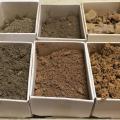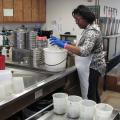Soil Testing
For a few dollars per sample, the Mississippi State University Extension Service Soil Testing Laboratory can tell you the pH, the lime requirement, plant-available phosphorus, plant-available potassium, and the levels of magnesium, zinc, and calcium in your soil, and furthermore, give some suggestions on what to do about them!
Obviously, there is some very powerful chemistry at work in soil testing. It is not necessary for Master Gardeners to know exactly what extractions and procedures occur in the lab. However, they should be aware that all testing laboratories do not use the same chemicals to analyze the soil and thus different numbers may be reported back for nutrient levels for the same soil. But, the absolute number is not the important thing! More on that later in the show.
Quality Soil Testing -- Taking the Sample
The value of soil test results is only as good as the sample analyzed. Poor sampling techniques result in an example of the old computer maxim "Garbage In Garbage Out" or GIGO.
The first step in quality in soil testing is to identify areas of like management. It would be counterproductive to combine soil samples from lawns and flower beds in one large sample. Each area should sampled separately. Think back to the soil formation factors and the effects of humans on individual soils in the introductory soils section.
Taking a sample requires a little equipment and an appreciation of randomness. If many samples are to be taken, a soil probe should be used. These are hollow metal tubes which are inserted in the soil and remove a cylinder of soil when pulled out. If only a few samples are required, and no probe is available, a garden trowel will suffice if subsequent handling is done as described below.
The randomness factor is extremely important for quality. Pull several samples from the management area (lawn, garden, flowerbed, etc) while walking through it in a zigzag pattern and place them in a plastic bucket. Crumble each subsample and mix all of them together. Fill a soil test box (available from your local MSU-ES office) with mixed soil. Mark the box with your name and an location identifier such as 'lawn' or 'westbed' that makes sense to you. It doesn't have to make sense to anyone else.
Submitting Samples
To get the samples run at the MSU-ES Soil Testing Lab, take them to your local Extension office and fill out the submission forms there. You will be asked to identify the future use of the site where the soil was obtained. This information allows the Lab to make crop or ground-cover specific recommendations based on the chemical analysis of the sample. Submit one fee per sample. In most months, the results will be back to you in less than 10 working days. It may be longer in the very busy spring months.
There are other reputable laboratories that will provide the same services as the MSU-ES lab. Contact them for information on sample submission and costs. The techniques of taking the sample from the home landscape are not different, however the chemistry used between labs is often different, and may yield different absolute numbers for nutrient content of soils.
Reading and Interpreting the Soil Test Report
Introduction
This discussion will use example reports from the author's front lawn and a private vegetable garden in south Mississippi.
A MSU-ES soil test report is in effect a business letter addressed to the person identified on the submission form. There will be one generated for each sample submitted. Below the salutation it will review the information provided by you about crops to be grown and the field identification.
Results
Lawn laboratory results:
Soil pH is 7.1
Phosphorus level is 27 lbs/acre (low)
Potassium level is 102 lbs/acre (low)
Magnesium level is 161 lbs/acre (low)
Zinc level is 2.5 lbs/acre (low)
Calcium level is 11910 lbs/acre (low)
Garden laboratory results:
Soil pH is 7.3
Phosphorus level is 99 lbs/acre (high)
Potassium level is 280 lbs/acre (high)
Magnesium level is 249 lbs/acre (very high)
Zinc level is 2.5 lbs/acre (high)
Calcium level is 5084 lbs/acre (low)
Total soluble salts is 0.2 (low)
pH
The first line of soil test results is the soil pH. This is the most important number on the soil test report. The pH of a soil is the master variable controlling the solubility, and thus the plant availability of many nutrients. Moreover, the particular microbial community in a soil depends on the pH level which further affects the fertility status.
A knowledge of plant material is important for horticultural management of pH. Desirable characteristics of some plants, for example bloom color, depend on soil acidity levels. The pH of both these examples is alkaline, which means over 7. If the pH is below 7 the soil is acid.
The alkaline pH of these soils represent two unusual cases. In the lawn example from Starkville, the acid topsoil was removed during construction of the house, exposing the alkaline subsoil common to the area. The example from south Mississippi probably represents over-management of the garden, i.e. too much lime applied. In the area this sample came from, acid soils are more common, as in the majority of Mississippi. However, there are regions where alkaline topsoils can be found. These include the Blackland prairie zone centered around Noxubee, Lowndes, and Clay counties, and along the Mississippi River due to water movement of salts up the soil profile.
Recommendations about soil acidity, or alkalinity, are covered below and in the other Master Gardener Soils Training modules on Basic Soils and Soil Fertility.
Phosphorus
Adequate phosphorus (P) nutrition is critical for plant growth and development. In these examples, P in the lawn sample is low at 27 pounds per acre, and high in the vegetable garden at 99 pounds per acre. The absolute number is not the most important feature of this line! Instead the low and the high are the important facts learned from these examples.
Each cropping use has had its response to different fertility levels characterized. Low for the Saint Augustinegrass lawn means a distinguishable plant growth response to added P fertilizer will occur 95 percent of the time. Conversely, high in the vegetable garden indicates there will likely be little response to P fertilization.
Low and high are called indexes or indices. Other index values used by the MSU-ES are very high and medium for fertility levels. Very high means fertilizer is not required, and medium is exactly that: medium, meaning fertility management is up to the operator.
Potassium
Potassium (K) levels are very low in the lawn example and high in the vegetable garden. Again, an index system is used to predict likely responses to fertilizer application.
Further information on P and K fertility management is available in the Fertility section of the Master Gardener Soils material.
Magnesium
Magnesium is the central core of the chlorophyll molecule. Plant growth will be poor and stunted when it is deficient. The magnesium (Mg) levels of these samples are medium and very high, but notice the numbers are not that far apart.
Zinc
The zinc levels are adequate for these crops. Zinc and other micro-nutrients usually do not present fertility problems, except in specialized cases when soil acidity is neither very high (pH near 4) or very low (pH near 8).
It is important to know the various plant material specific cases where micro-nutrient management may be critical. That information is available elsewhere in the Master Gardener training material.
Calcium
Calcium plant availability is seldom a problem, unless a soil has low pH. However, it can vary widely as seen in these two examples, and problems such as blossom-end rot in tomatoes may occur due to calcium deficiency.
Common liming materials contain a great deal of calcium and will increase soil levels when applied to adjust pH.
Soluble Salts
When soluble salts are high, there are potential problems of reduced water availability or toxicity of specific ions such as chloride or bicarbonate. Salt problems can arise when soils are irrigated, but have inadequate drainage.
Recommendations
Both soil test reports in these examples say:
Soil test results indicate:
pH of soil is alkaline.
no lime is recommended for this crop.
But lower on the page there is something to the effect:
Apply lime, if recommended, in the fall or winter. . . .
and the other:
If lime or slag is recommended, it may be applied. . . .
Some computer logic is required. Read the comments closely and note the "if." The application recommendations for lime are given regardless of the application whether it's 0 or X pounds per 1000 square feet.
That brings up another point. Know, by measuring, the area of soil to be treated and apply only the recommended quantities of material to that area. Agronomic recommendations are given on a per acre basis. There are 43560 square feet per acre. Horticultural recommendations are made on a 1000 square foot basis. There are 2950 square feet in the front yard example.
No P or K or lime are recommended for the example vegetable garden because the soil test shows sufficient P and K to produce a vegetable crop is available in the soil. The pH is near neutrality and does not require adjustment with lime.
The printout will have a recommendation for nitrogen (N) application. It is too warm and humid in Mississippi for soil N tests to have any predictive power. Recommendations are made to provide adequate plant nutrition and remain environmentally friendly. More information about N in Mississippi soils is available.
The lawn example has a recommendation of two applications of fertilizer for Saint Augustinegrass. Seven pounds of 5-15-30 by May 1, and then 6.5 pounds more 5-15-30 by June 1. The very important point is made that other grades of fertilizer may be substituted that provide the same quantity of plant food.
Master Gardeners should know how to calculate rates using other grades of fertilizer to accomplish that task!
Summary
This has worked you through taking a soil sample, submitting it, and interpreting the results. More information is available through your local Extension agent and Master Gardener coordinator.
Publications
News
Early fall is one of the best times to test your soil. A soil test can tell you if your lawn or garden needs critical nutrients and how much. This way, your plants and your wallet will stay healthy. You won’t waste your money applying fertilizer or lime that your plants don’t need.
Sweet potato growers in Mississippi can get free nematode testing of soil samples they send to Mississippi State University from now until Dec. 31, 2024. The samples can be submitted in nematode bags available at local county MSU Extension Service offices; samples are also accepted in quart-sized, sealed plastic bags.
Having healthy soil in your garden results in healthy plants. Whether you’re planting vegetables, flowers, grass, trees, shrubs, or anything in between, a soil sample is the first thing to check off the list. Gathering a soil sample from your landscape and having it tested by MSU Extension’s Soil Testing Lab should be the initial step in any gardening adventure. Plus, it’s pretty easy to do!





